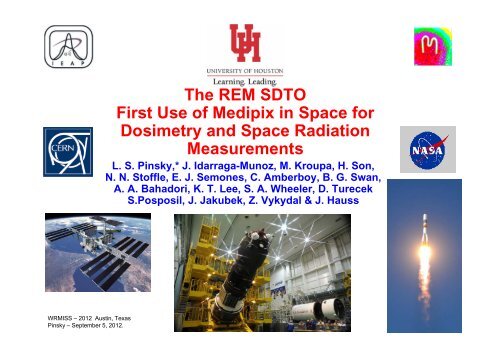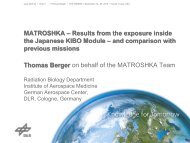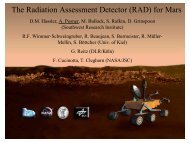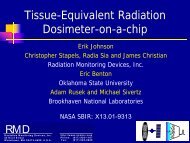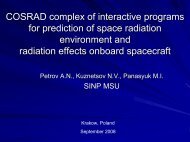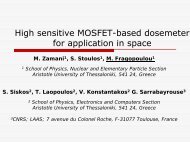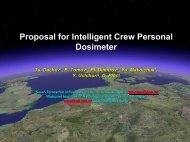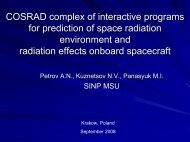First Results (Hopefully) from Medipix on the ISS - Wrmiss.org
First Results (Hopefully) from Medipix on the ISS - Wrmiss.org
First Results (Hopefully) from Medipix on the ISS - Wrmiss.org
- No tags were found...
You also want an ePaper? Increase the reach of your titles
YUMPU automatically turns print PDFs into web optimized ePapers that Google loves.
The REM SDTO<str<strong>on</strong>g>First</str<strong>on</strong>g> Use of <str<strong>on</strong>g>Medipix</str<strong>on</strong>g> in Space forDosimetry and Space Radiati<strong>on</strong>MeasurementsL. S. Pinsky,* J. Idarraga-Munoz, M. Kroupa, H. S<strong>on</strong>,N. N. Stoffle, E. J. Sem<strong>on</strong>es, C. Amberboy, B. G. Swan,A. A. Bahadori, K. T. Lee, S. A. Wheeler, D. TurecekS.Posposil, J. Jakubek, Z. Vykydal & J. HaussWRM<strong>ISS</strong> – 2012 Austin, TexasPinsky – September 5, 2012.1
L. S. Pinsky 1 *, C. Amberboy 4 , A. Bahadori 4 , A. Empl 1 , J. Hauss 4 , S<strong>on</strong>Hoang 1 , J. Idarraga 1 , J. Jakubek 2 , H. Kitamura 3 , M. Kroupa 1 , K.Lee 4 , S. Pospisil 2 , E. Sem<strong>on</strong>es 4 , N. Stoffle 1 , B.G. Swan 4 , D. Turecek 2 , Y.Uchihori 3 , Z. Vykydal 2 & Scott Wheeler 41University of Houst<strong>on</strong>, USA. 2 Institute of Experimental and AppliedPhysics, Czech Technical University in Prague, Czech Republic.3Nati<strong>on</strong>al Institute for Radiological Sciences, Chiba, Japan.4@NASA/JSC, USAWith Support From:Last yearinPrague…Michael Campbell,(<str<strong>on</strong>g>Medipix</str<strong>on</strong>g>Collaborati<strong>on</strong>Spokespers<strong>on</strong>)&Ian McGill &Allan H<strong>on</strong>ma,(CERN B<strong>on</strong>ding Lab)WRM<strong>ISS</strong> – 2012 Austin, TexasPinsky – September 5, 2012.3
The <str<strong>on</strong>g>Medipix</str<strong>on</strong>g>2 C<strong>on</strong>sortium—CERN-BasedInstitut de Fisca d'Altes Energies, Barcel<strong>on</strong>a, SpainUniversity of Cagliari and INFN Secti<strong>on</strong> <strong>the</strong>reof, ItalyCEA, Paris, FranceCERN, Geneva, Switzerland,Universitat Freiburg, Freiburg, Germany,University of Glasgow, ScotlandUniversita' di Napoli and INFN Secti<strong>on</strong> <strong>the</strong>reof, ItalyNIKHEF, Amsterdam, The Ne<strong>the</strong>rlandsUniversity of Pisa and INFN Secti<strong>on</strong> <strong>the</strong>reof, ItalyUniversity of Auvergne, Clerm<strong>on</strong>t Ferrand, France,Laboratory of Molecular Biology, Cambridge EnglandMitthogskolan, Sundsvall, Sweden,Czech Technical University, Prague, Czech RepublicESRF, Grenoble, FranceAcademy of Sciences of <strong>the</strong> Czech Republic, PragueUniversität Erlangen-Nurnberg, Erlangen, GermanyUniversity of California-SSL, Berkeley, USAUniversity of Houst<strong>on</strong>, Houst<strong>on</strong>, Texas USAWRM<strong>ISS</strong> – 2012 Austin, TexasPinsky – September 5, 2012.4
TimePix Versi<strong>on</strong> Logic Schematic• Charge sensitive Preamp/Shaper w/ individual leakage current compensati<strong>on</strong>• Discriminator with globally adjustable thresholds & individual 4-bit fine tuning offset• Individually settable test and mask bits for each pixel• External shutter gates <strong>the</strong> clock (can be as short as 10 ns but 1 s is <strong>the</strong> practical limit)• 14-bit output register (11,810 decimal)• 1 Overflow bit• Each pixel can have its modeset independentlyWRM<strong>ISS</strong> – 2012 Austin, TexasPinsky – September 5, 2012.8
Time-Over-Threshold (“ADC”) Mode(P0=1,P1=0)33 50 122Ke - 4Ke - 2Ke - “Shutter” WindowDiscriminator OutputAnalog SignalsClock Out10MHzThreshold100MHzWRM<strong>ISS</strong> – 2012 Austin, TexasPinsky – September 5, 2012.9
TimePix Threshold Calibrati<strong>on</strong>Calibrates <strong>the</strong> 4-bit (16 level) Threshold Offsets for eachpixel. The RED histogram is <strong>the</strong> distributi<strong>on</strong> of noise turn-<strong>on</strong>points with all bits set to high. The BLUE histogram is <strong>the</strong>corresp<strong>on</strong>ding low setting. The BLACK histogram is <strong>the</strong>corrected result. Each channel is ~20 e - …WRM<strong>ISS</strong> – 2012 Austin, TexasPinsky – September 5, 2012.10
TimePix and its TOT modeCounter in each pixel can be used asTimer to measure detecti<strong>on</strong> time => TOF experiments, TPC detectors, …Wilkins<strong>on</strong> type ADC to measure energy of each particle detected.TOTCalibrati<strong>on</strong>curveIf <strong>the</strong> pulse shape is triangular <strong>the</strong>n Time overThreshold is proporti<strong>on</strong>al to collected charge i.e. toenergy.Due to limited bandwidth <strong>the</strong> pulse can be NEVERperfectly triangular.EnergyN<strong>on</strong>-linear TOT to energy dependenceEnergyThresholdWRM<strong>ISS</strong> – 2012 Austin, TexasPinsky – September 5, 2012.TimeJan Jakůbek11
Development of Flight Hardware &Software for NASA @ IEAP, CERN & UHIEAP• Designed USB Lite Interface…• Calibrated Flight Units…• Provided <strong>the</strong> Core FlightSoftware…CERN• <str<strong>on</strong>g>Medipix</str<strong>on</strong>g>2 Collaborati<strong>on</strong>Provided Timepix DetectorAssemblies…• CERN B<strong>on</strong>d-Lab attached <strong>the</strong>Detector Assemblies to USBBoards.UH• Managed Overall Project…• Develop Analysis Software andFlight Software Algorithms…• C<strong>on</strong>formal Coating…Stackable C<strong>on</strong>nectorsWRM<strong>ISS</strong> – 2012 Austin, TexasPinsky – September 5, 2012.12
Radiati<strong>on</strong> Envir<strong>on</strong>ment M<strong>on</strong>itor(“REM”)NASA <strong>ISS</strong> SDTO Flight Hardware!WRM<strong>ISS</strong> – 2012 Austin, TexasPinsky – September 5, 2012.13
Each USB Interface Can Support Up To4 Detectors, Enabling StacksWRM<strong>ISS</strong> – 2012 Austin, TexasPinsky – September 5, 2012.14
800 MeV/A Si 85 degree TracksThe tracks are <str<strong>on</strong>g>from</str<strong>on</strong>g>particles divingdownward <str<strong>on</strong>g>from</str<strong>on</strong>g> left toright.As <strong>the</strong>y pass though<strong>the</strong> solder-bumps andinto <strong>the</strong> underlying chipafter leaving <strong>the</strong> Sidetector layer.Some of <strong>the</strong> highenergy -rays <str<strong>on</strong>g>from</str<strong>on</strong>g> <strong>the</strong>chip enter <strong>the</strong> overlyingdetector layer…15WRM<strong>ISS</strong> – 2012 Austin, TexasPinsky – September 5, 2012.
“Film-Badge” Equivalent Dosimetry100 sec @ 11,000 m in a777 over <strong>the</strong> Bering Sea1000 Sec in my officein Houst<strong>on</strong>This in flight Dose Rate is 50 to 100 times that in my office…WRM<strong>ISS</strong> – 2012 Austin, TexasPinsky – September 5, 2012.16
20Ne @ 600 MeV/A & 15° w/ IKRUM =5• Note that even at anIKRUM of 5 <strong>the</strong>re are“Ghost” tracks…• Note also that <strong>the</strong>“Normal” Tracks ALLhave clearly visible -rays…• Also <strong>the</strong> asymmetryof <strong>the</strong> cluster isclearly pr<strong>on</strong>ounced at15 degrees <str<strong>on</strong>g>from</str<strong>on</strong>g>normal incidence…WRM<strong>ISS</strong> – 2012 Austin, TexasPinsky – September 5, 2012.17
20Ne at 600 MeV/A Drift ImageWRM<strong>ISS</strong> – 2012 Austin, TexasPinsky – September 5, 2012.18
Determining <strong>the</strong> Projected Track LengthIn order to determine <strong>the</strong>LET that a particle had <str<strong>on</strong>g>from</str<strong>on</strong>g>its track image, we need toestimate <strong>the</strong> projected tracklength. We know <strong>the</strong>thickness of <strong>the</strong> sensor andwe can measure <strong>the</strong> energyloss by summing <strong>the</strong> pixels in<strong>the</strong> cluster…The method chose forreal-time processing is to doa selective subtracti<strong>on</strong> ofpixels to determine <strong>the</strong> “core”length and “skirt” width. Anempirically-based algorithmhas bee developed using awide variety of beams andenergies at <strong>the</strong> HIMAC facilityin Japan.WRM<strong>ISS</strong> – 2012 Austin, TexasPinsky – September 5, 2012.19
Real-Time Angular Resoluti<strong>on</strong>The algorithm described <strong>on</strong> <strong>the</strong> previous slide has a reas<strong>on</strong>ableresoluti<strong>on</strong> for angles above 15° with a 300m thick sensor asThicker sensors (500 m to 1 mm) have good angularresoluti<strong>on</strong>s down to < 5°, and <strong>the</strong> error introduced to <strong>the</strong> LETestimate are still dominated by <strong>the</strong> Landau fluctuati<strong>on</strong>s. Thefigures below are for 160 MeV/A He with 1 mm sensors…For ground-based analysis a global cluster-fitting routine isunder development and offers even better resoluti<strong>on</strong>…30° 60° 75°WRM<strong>ISS</strong> – 2012 Austin, TexasPinsky – September 5, 2012.20
f,#" *%T#+*%H$L' ,)+D"HB+' " #F4#$$%N +D %AB$%I0K%)/ %:,#LB*21:#L*%7k%J%SO
fTH%0*(F/ L%9)+D%pcT#%N +D %AB$%I0K%)/ %:,#LB*22:#L*%=j %J%SO
Simulating an SAA Pass with <strong>the</strong>Flight Units @ HIMACFive Flight Units were translated laterally through <strong>the</strong>beam while running <strong>the</strong> Flight Software. The displayabove c<strong>on</strong>tains <strong>the</strong> Flight interface for each unit.WRM<strong>ISS</strong> – 2012 Austin, TexasPinsky – September 5, 2012.23
Flight SoftwareDaniel Turecek,IEAP…with routinessupplied by UHGraduateStudents: NicStoffle (Physics)and S<strong>on</strong> MinhHoang (ComputerScience)…Automatic frame integrati<strong>on</strong> time adjustment…Cluster-Finder…Track-Projecti<strong>on</strong> length estimator (needed to Calculate LET)…LET Calculator…Robust SEE and SEU recovery capability…Daily raw data downloads…Accessible input parameter file…WRM<strong>ISS</strong> – 2012 Austin, TexasPinsky – September 5, 2012.24
Ground-Based SoftwareTo be ROOT-BasedInitial versi<strong>on</strong>s areoperati<strong>on</strong>al, but needc<strong>on</strong>catenati<strong>on</strong>…General Data &Software Repositoryat UH…CERN/LHC-basedAnalysis Procedure• Raw => DST => AOD• Standard Routines toproduce DST and“Filters” to AODs…WRM<strong>ISS</strong> – 2012 Austin, TexasPinsky – September 5, 2012.Standard RoutinesCluster FinderCluster Dis-AmbiguityCluster Angle FinderCluster Energy TotalCluster -RayEvaluati<strong>on</strong>LET Determinati<strong>on</strong>Q-Factor EstimatorDose EndpointEstimators…25
…AND, This is Where They Are NOW!WRM<strong>ISS</strong> – 2012 Austin, TexasPinsky – September 5, 2012.26
Progress 48 Being AssembledWRM<strong>ISS</strong> – 2012 Austin, TexasPinsky – September 5, 2012.27
Progress 48 On <strong>the</strong> Launch Padin Baik<strong>on</strong>urWRM<strong>ISS</strong> – 2012 Austin, TexasPinsky – September 5, 2012.28
Progress 48 Liftoff…August 2, 2012WRM<strong>ISS</strong> – 2012 Austin, TexasPinsky – September 5, 2012.29
…And, Same Day Arrival at <strong>the</strong> <strong>ISS</strong>(August 2)WRM<strong>ISS</strong> – 2012 Austin, TexasPinsky – September 5, 2012.30
L<strong>on</strong>g Term Goals for <str<strong>on</strong>g>Medipix</str<strong>on</strong>g> in SpaceWe plan to use <strong>the</strong> SDTO to obtain experience with<strong>the</strong> current Timepix technology in space…• Both with <strong>the</strong> current USB interface where power andc<strong>on</strong>nectivity are available…• And, a stand-al<strong>on</strong>e, battery-powered, wireless versi<strong>on</strong> in orderto influence <strong>the</strong> design of a low-power (probably dedicated)<str<strong>on</strong>g>Medipix</str<strong>on</strong>g>3-based device……With <strong>the</strong> ultimate goal of having several types of<str<strong>on</strong>g>Medipix</str<strong>on</strong>g>-based devices with both charged particleand neutr<strong>on</strong> capability deployed operati<strong>on</strong>ally…• A stand-al<strong>on</strong>e battery-powered, wireless pers<strong>on</strong>al dosimeterwith local readout, and alarm capability, al<strong>on</strong>g with a ~30-daybattery life and <strong>the</strong> size of a typical current smart-ph<strong>on</strong>e.• In-suit EVA radiati<strong>on</strong> m<strong>on</strong>itors coupled to existing spacesuitbuilt-in power and data interfaces.• Wireless & wired area m<strong>on</strong>itors for use in spacecraft andPlanetary and Lunar habitats…WRM<strong>ISS</strong> – 2012 Austin, TexasPinsky – September 5, 2012.31
Thank You for Your Attenti<strong>on</strong>WRM<strong>ISS</strong> – 2012 Austin, TexasPinsky – September 5, 2012.32
AESCrew SystemsProject:Ongoing Development Projects:NASA Advanced Explorati<strong>on</strong> SystemsRadiati<strong>on</strong> Protecti<strong>on</strong>:This project isdeveloping radiati<strong>on</strong>shielding, radiati<strong>on</strong>analysis tools, andadvanced dosimetrysensors to protect<strong>the</strong> crew against <strong>the</strong>harmful effects ofspace radiati<strong>on</strong>.WRM<strong>ISS</strong> – 2012 Austin, TexasPinsky – September 5, 2012.Approval to fly <strong>on</strong> ETF-1 has beenobtained and 2 Timepix units areplanned to fly inside <strong>the</strong> <str<strong>on</strong>g>First</str<strong>on</strong>g> TestFlight of <strong>the</strong> new US Manned Ori<strong>on</strong>Module33
EFT-1WRM<strong>ISS</strong> – 2012 Austin, TexasPinsky – September 5, 2012.34
…AND in Habitats…Bigelow Aerospace, a USPrivate Company isplanning to deploy an“Inflatable” Habitat Moduleattached to <strong>the</strong> <strong>ISS</strong>, andNASA will evaluate itssuitability for l<strong>on</strong>g termspace and surface habitattechnology… Currentplans are to do radiati<strong>on</strong>measurements existing<str<strong>on</strong>g>Medipix</str<strong>on</strong>g> technology(Laptops and USBinterfaces)WRM<strong>ISS</strong> – 2012 Austin, TexasPinsky – September 5, 2012.35
LUCID – Langt<strong>on</strong> Ultimate Cosmic ray Intensity DetectorTimePix’s <str<strong>on</strong>g>First</str<strong>on</strong>g> Space Missi<strong>on</strong>—Educati<strong>on</strong>al Outreach(UK Satellite “TechDemo-1” to be Launched Q1—2013)Velocity5 TimePix Detectors (0.7 mm Al dome)Sun-Synchr<strong>on</strong>ous Polar Orbit (98° @11:00)Programmable Signal Processor for<strong>on</strong>-orbit data analysis…WRM<strong>ISS</strong> – 2012 Austin, TexasPinsky – September 5, 2012.Down36
Educati<strong>on</strong>al Outreach• PI is Becky Parker <str<strong>on</strong>g>from</str<strong>on</strong>g> <strong>the</strong>Langt<strong>on</strong> School inCanterbury, UK.• Data will be available inDaily downloads to HighSchool groups worldwidevia <strong>the</strong> Web…• Online analysis tools willbe provided…• Correlati<strong>on</strong>s with surfaceCosmic Ray Detectorsdeployed in schoolsworldwide is possible…CERN@School• TimePix kits are beingprovided for laboratoryuse.WRM<strong>ISS</strong> – 2012 Austin, TexasPinsky – September 5, 2012.LUCID37
LUCID is Planned to be Launchedby an Indian Launch VehicleThe orbit will beSun-Synchr<strong>on</strong>ous(at 11:00) with a600 Km circularorbit at 98°.This will allow it tosample both <strong>the</strong>inner and outertrapped radiati<strong>on</strong>belts.WRM<strong>ISS</strong> – 2012 Austin, TexasPinsky – September 5, 2012.38
NASA <strong>ISS</strong> Detailed Test Objective(SDTO) StatusA special versi<strong>on</strong> of Pixelman(Pixelman<strong>ISS</strong>) has been uploaded to<strong>the</strong> 21 <strong>ISS</strong> (Lenovo) Laptops…(Thanks to Daniel Turecek)5 “Flight Units” have been transferredto Biak<strong>on</strong>ur (Kazakhstan), and arewaiting <strong>the</strong>re for a (scheduled) July 31Launch <strong>on</strong> <strong>the</strong> Progress-48 SupplyVehicle to <strong>the</strong> <strong>ISS</strong>.Within a few weeks, first <strong>on</strong>e, <strong>the</strong>n allfive units will be plugged into 5separate laptops and plans are toacquire data for 2-3 weeks.All raw frame data will be downloadedseveral times each day for analysis <strong>on</strong><strong>the</strong> groundWRM<strong>ISS</strong> – 2012 Austin, TexasPinsky – September 5, 2012.39
SummaryThe NASA Project hasmorphed into severalseparate projects…NASA is leaning towardsusing a dedicateddesign(s)…They are ready to beginacquiring detectors <str<strong>on</strong>g>from</str<strong>on</strong>g><strong>the</strong> licensees as so<strong>on</strong> as<strong>the</strong>y are able to supply<strong>the</strong>m reliably…It appears that thicker Sisensors are preferable…WRM<strong>ISS</strong> – 2012 Austin, TexasPinsky – September 5, 2012.40
Offline (Ground-Based) Analysis Software ToBe Available my mid-July (John Idarraga)ROOT-Based…• Maintained by CERN…• Free for Researchapplicati<strong>on</strong>s…• Designed to handlemassive data sets…• Uses “C” as <strong>the</strong> scriptinglanguage (allows scriptsto be compiled for fasteranalysis executi<strong>on</strong>!)• Runs <strong>on</strong> all platforms…<str<strong>on</strong>g>Hopefully</str<strong>on</strong>g> will incorporateall existing routines andplug-ins <str<strong>on</strong>g>from</str<strong>on</strong>g> current IEAP“Pixelman” software…Can also be used as a DAQsoftware…WRM<strong>ISS</strong> – 2012 Austin, TexasPinsky – September 5, 2012.41
TimePix ModesTime-Over-Threshold (TOT) >>> “ADC” Mode• During Shutter Open, Counter Clock pulses are added toOutput Register while shaped input pulse exceedsThreshold value.TimePix >>> “TDC” Mode• During Shutter Open, Counter Clock pulses are added toOutput Register starting when shaped input pulse firstexceeds Threshold value.<str<strong>on</strong>g>Medipix</str<strong>on</strong>g> >>> “Hit” Counter Mode• While <strong>the</strong> Shutter is Open, <strong>the</strong> Output Register isIncremented every time <strong>the</strong> shaped input pulse leadingedge crosses <strong>the</strong> Threshold value.WRM<strong>ISS</strong> – 2012 Austin, TexasPinsky – September 5, 2012.42
Timepix (“TDC”) Mode(P0=1,P1=1)openclose“Shutter”17Clock Start164StopDiscriminator OutputAnalog Signals10MHz100MHzWRM<strong>ISS</strong> – 2012 Austin, TexasPinsky – September 5, 2012.43
Calibrati<strong>on</strong> Curves& Functi<strong>on</strong>al Formf( x)ax bc( xt)dMeaning of parameters:a,b – linear regressi<strong>on</strong> in high energy rangec,d – curvature (extent and symmetry)t – thresholdParameters computedUsing global calibrati<strong>on</strong>data:a=0.158b=4.65c=2.4d=1t=4.86WRM<strong>ISS</strong> – 2012 Austin, TexasPinsky – September 5, 2012.Jan Jakůbek44
A USB based <str<strong>on</strong>g>Medipix</str<strong>on</strong>g>2 Readout System Is AvailableExisting USB-1 compatibleDeveloped by S. Pospisil et al.CTU, Prague…USB-2 Versi<strong>on</strong>-Hardware IS Ready( and waiting for <strong>the</strong> software…)WRM<strong>ISS</strong> – 2012 Austin, TexasPinsky – September 5, 2012.45
CreditsFunding- SRAG (& Wyle) @ NASA/JSC…Timepix Design—<str<strong>on</strong>g>Medipix</str<strong>on</strong>g> Collaborati<strong>on</strong>Timepix Fabricati<strong>on</strong>—IBMDetector Layer Fabricati<strong>on</strong>--CanberraWire-b<strong>on</strong>ding—CERN B<strong>on</strong>ding LabUSB-Lite interface Design and Development—IEAP, Czech Technical University in PragueUSB-Lite Layout and Fabricati<strong>on</strong>—Ales BurianFlight Software—IEAP, Czech TechnicalUniversity in Prague & UHHeavy I<strong>on</strong> Beam Testing—HIMAC @ NIRSCoordinati<strong>on</strong> NASA JSC…WRM<strong>ISS</strong> – 2012 Austin, TexasPinsky – September 5, 2012.46
ATLAS Area Neutr<strong>on</strong> M<strong>on</strong>itorsDetector C<strong>on</strong>figurati<strong>on</strong><str<strong>on</strong>g>Medipix</str<strong>on</strong>g>2 ASIC with 300µm Sisensor + USB interfaceNeutr<strong>on</strong> c<strong>on</strong>versi<strong>on</strong> structures:1)LiF+50µm Al foil area2)100µm Al foil area3)PE area4)PE+50µm Al foil area5)Uncovered areaX-ray image of c<strong>on</strong>versi<strong>on</strong> layersLiFPEPE + AlAlUncoveredWRM<strong>ISS</strong> – 2012 Austin, TexasPinsky – September 5, 2012.47
Neutr<strong>on</strong> efficiency calibrati<strong>on</strong>(see also poster 3.2.4 of Dominic Greiffenberg)Calibrated efficiency:Thermal: 1.41E-2 ± 7.11E-4 cm -2 s -1252Cf: 1.19E-3 ± 1.89E-5 cm -2 s -1AmBe: 2.86E-3 ± 5.46E-5 cm -2 s -1LiFX-ray image of c<strong>on</strong>versi<strong>on</strong> layersPEThermal neutr<strong>on</strong>s – 500s, 25meVVDG: 7.23E-3 ± 5.81E-4 cm -2 s -1 48PE / PE+Al cluster count ratio:252Cf: 10.70 ± 0.04AmBe: 5.18 ± 0.03VDG: 2.51 ± 0.03AlUncoveredPE + Al252Cf – 2000s, 2MeV (mean)AmBe – 2000s, 4MeV (mean)Van de Graaff – 1000s, 14MeVWRM<strong>ISS</strong> – 2012 Austin, TexasPinsky – September 5, 2012.


